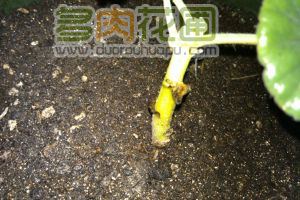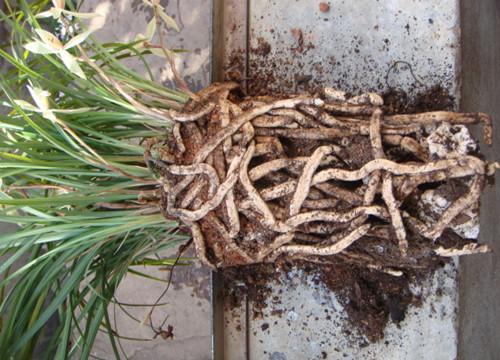Control methods of Leaf spot of Pelargonium
[symptoms] at the beginning of the disease, chlorotic spots appeared on the susceptible leaves, and then the lesions gradually expanded to form large round spots. The disease spot is dark brown and has concentric rings. In the later stage of the disease, a black-green mold layer appeared on the disease spot, which was the conidia of the pathogen. [occurrence regularity] pathogens overwintered with mycelium in diseased remains or diseased tissues. Conidia are produced when the environmental conditions are suitable. Conidia are infected by wind and rain. During the growing season, conidia can repeatedly infect plants. The pathogen can invade directly from stomata, lenticels or epidermis, form primary infection, appear disease spot after 2-3 days incubation, produce conidia in 3-4 days, and repeatedly infect through airflow and Rain Water.
On the same day, when the geranium entered the blooming period, the basal leaves began to age and the bacteria accumulated on the plant. at this time, the disease began to occur and spread when the relative humidity of continuous rain was more than 70%. Therefore, sooner or later the rainy season comes, the number of rainy days, the size and distribution of rainfall, all affect the outbreak and epidemic of the disease.
[prevention and control methods] ① reduced the source of infection. Diseased leaves were cut off in time, together with concentrated destruction of diseased leaves; ② chemical control. At the initial stage of the disease, spray 1 Vera 200 Bordeaux solution, or 50% bacillus special wettable powder, or 65% Dyson zinc wettable powder 600 times 800 times, once every 10 to 15 days, 2 times for 3 times.
Control methods of Leaf spot of Pelargonium
Distribution and harm
Geranium leaf spot is a common disease in spring and summer. It is most likely to occur in high temperature and rainy season, which often causes most of the susceptible leaves to die and fall off. When the stem was infected, it blackened, wilted and rotted, and the vascular bundles browned and blackened at the base. Cuttings can not take root, from the stem began to rot, and upward development, resulting in leaf wilting and death.
Symptom
Geranium leaf spot disease, including black brown disease and brown spot disease.
Black spot: primary watery spot on the leaf, semicircular to amorphous, and then round, 2 to 3 mm in diameter, with slightly sunken necrotic spots in the center. The larger plaque is 6 to 10 mm in diameter. Often restricted by the veins of the leaves, it is irregular, dark brown, with concentric patterns and less black mildew layer. The disease spots on the leaf spots are scattered or confluent, and when the leaves are serious, the leaves turn black, wrinkle and die. The disease is more common in the lower old leaves of the plant, but the upper leaves are also vulnerable.
Brown spot: leaf spot round or ovate, 1 to 4 mm in diameter, light brown, grayish white to brick red, with dark brown narrow edges, sometimes slightly bulging under the leaf, scattered with black grains or dark gray mildew layers.
Pathogen
The pathogens of the above two kinds of leaf spot disease are all semi-known subphylum fungi. The amorphous brown spots are caused by the infection of Alternaria. The subround gray brown spot is caused by the infection of Cercospora, Phytophthora and Cercospora.
Occurrence regularity
The above bacteria were first and again infected by conidia in spring and summer by means of wind and rain. Especially in the high temperature and rainy season, diseases are easy to occur. Often by watering, wind and rain, water droplets spatter to the leaves, mainly through knives and other horticultural tools contact transmission, from the wound □ invasion. If the environment is humid and the plant grows too dense, it is easy to cause the disease. Distribution and harm of Pelargonium Leaf spot Disease is a common disease in spring and summer. Leaf spot disease is most likely to occur in high temperature and rainy season, which often causes death and shedding of most susceptible leaves. When the stem was infected, it blackened, wilted and rotted, and the vascular bundles browned and blackened at the base. Cuttings can not take root, from the stem began to rot, and upward development, resulting in leaf wilting and death. Symptoms of geranium leaf spot, including black brown disease and brown spot. Black spot: primary watery spot on the leaf, semicircular to amorphous, and then round, 2 to 3 mm in diameter, with slightly sunken necrotic spots in the center. The larger plaque is 6 to 10 mm in diameter. Often restricted by the veins of the leaves, it is irregular, dark brown, with concentric patterns and less black mildew layer. The disease spots on the leaf spots are scattered or confluent, and when the leaves are serious, the leaves turn black, wrinkle and die. The disease is more common in the lower old leaves of the plant, but the upper leaves are also vulnerable. Brown spot: the spot on the leaf is round or ovate, 1 to 4 mm in diameter, light brown, grayish white to brick red, with dark brown narrow edges, sometimes slightly bulging under the leaf, with black grains or dark gray mold layers scattered on the spot. The pathogens of the above two kinds of leaf spot disease are all semi-known subphylum fungi. The amorphous brown spots are caused by the infection of Alternaria. The near-round gray brown spot is caused by the infection of Cercospora, Phytophthora and Cercospora. The occurrence regularity of the above bacteria were first and again infected by conidia in spring and summer by means of wind and rain. Especially in the high temperature and rainy season, diseases are easy to occur. Often by watering, wind and rain, water droplets spatter to the leaves, mainly through knives and other gardening tools contact transmission, invading from the wound. If the environment is humid and the plant grows too dense, it is easy to cause the disease. Prevention and control methods 1. Create ventilation and light transmission conditions to avoid excessive density of plants or branches, reduce humidity, and prevent branches and leaves from overgrowing. 2. Avoid sprinkler irrigation when watering to prevent sprinkling water from spreading germs. It should slowly infiltrate along the edge of the basin to prevent excessive watering, stagnant water in the basin and cause rotting roots. 3. when diseased leaves are found, they must be removed and destroyed in time. 4. Fertilization should not be excessive, too much nitrogen fertilizer will easily cause plant leaves to grow, not blossom or blossom less. More phosphorus and potassium fertilizer should be applied in early spring or early autumn. 5. Spray 50% benzoate wettable powder 2500 times or 1 ∶ 1 ∶ Bordeaux before onset. At the beginning of the disease, 50% anthrax Fumei + 80% mancozeb (1 ∶ 1) 1000 times, or 70% chlorothalonil + 70% topiramate (1 ∶ 1) 1000 times, 50% Bao Gong Ke wet powder 1000 times, the above drugs were sprayed 3 to 4 times alternately, once every 7 to 15 days, close before and after sparse, with good control effect.
- Prev

How to prevent the rotting roots of geraniums
Geranium, also known as stone red, Ren La Hong, Hydrangea, Hydrangea, is a subshrub or perennial herb of the family Niuer Seedling. The whole body is covered with fine hairs and has a special smell. Native to southern Africa, it is now widely cultivated all over the world. Like cold climate, suitable temperature 10-25 ℃, can withstand 0 ℃ low temperature
- Next

How to grow orchids? The six secrets shared by the old master of the orchid, once mastered, you can become a real master of the orchid.
It is said that orchids are difficult to raise, but it is even more difficult to raise them well. I often hear flower friends say that my orchids have not been grown for so long, and they do not look like any spirit, let alone blossom. However, every time I see such a good orchid raised by others, I envy it. So, how to raise orchids?
Related
- Fuxing push coffee new agricultural production and marketing class: lack of small-scale processing plants
- Jujube rice field leisure farm deep ploughing Yilan for five years to create a space for organic food and play
- Nongyu Farm-A trial of organic papaya for brave women with advanced technology
- Four points for attention in the prevention and control of diseases and insect pests of edible fungi
- How to add nutrient solution to Edible Fungi
- Is there any good way to control edible fungus mites?
- Open Inoculation Technology of Edible Fungi
- Is there any clever way to use fertilizer for edible fungus in winter?
- What agents are used to kill the pathogens of edible fungi in the mushroom shed?
- Rapid drying of Edible Fungi

